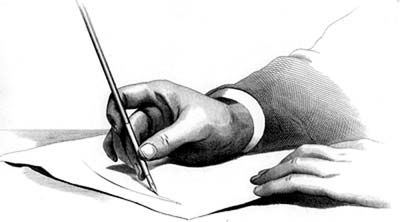Calligraphy in the 21st century: what do we lose in the disappearing art of beautiful handwriting?
When you have a laptop and a smart phone why bother about handwriting? However, the visitors of the International Exhibition of Calligraphy running at Sokolniki Exhibition and Convention Centre through November 14th wouldn’t even think of it. For them the skill of beautiful and neat handwriting is an art. Moreover, it is a religious art. The lore of the pen and ink is not only a beautiful art but has a real spiritual value. According to Yelena Isayeva, the exhibition’s curator, no matter what country calligraphers lived in they have always drawn their inspiration from religious and spiritual ideas. In his welcoming address, Kirill, Patriarch of Moscow and All Rus thanked the organizers for promoting Russian Orthodox values through the written word: “The touching beauty of Slavic script devised by Saints Cyril and Methodius can unite the representatives of different generations in their faith in the Russian culture and spiritual tradition.”
 Congratulations for Teacher by Yuri Koverdyayev
Congratulations for Teacher by Yuri KoverdyayevAttention to detail?
Calligraphy (from Ancient Greek: κάλλος kallos “beauty” + γραφή graphẽ “writing”) is an ancient art. We have always yearned to perpetuate our memories and pass our experience to our offspring; that is, basically, the reason why writing was devised in the first place. Slavic Cyrillic alphabet, Arabic lettering, Roman manuscripts, Chinese characters, Judaic scrolls, these are the paths of writing in different countries, just to name a few. However it is today that calligraphy is fast becoming fashionable stuff for the new generation, glued to the keyboard, tends to forget what the labours and joys of penmanship are.
Present day kids rarely take up a ball-pen, to say nothing of fountain pens or goose quills. Some would say, who cares what style you are writing in, what matters is what you write and to whom. However, psychologists think otherwise. “People used to write with quills, which required considerable skill. People were deeper in those days,” says Larisa Drygval, graphologist, Doctor of Psychology, an expert of Inessa Goldberg’s School of Scientific Graphic Analysis. Our grandparents were made to carefully practice each line. When you pay a lot of attention to detail, every detail becomes very important. You start to give preference to ritual and an orthodox way of life, the way others would see you. We find the question “How should I dress up for lunch?” ridiculous; we do not change the cutlery with every course and generally dismiss formality as something trifling and minor. Things that used to be commonly accepted conventions faded away or were simplified. We have switched to the lifeless keyboard. Thus we tend to drift farther and farther away from customs and traditions.
 Our grandparents were made to carefully practice each line.
Our grandparents were made to carefully practice each line.Pen and ink: reflection of the soul
The strong connection of the state of one’s mind and handwriting is a scientific fact. Graphology experts can tell a lot about the writer’s personal traits, her current mood and emotion by studying her handwriting. The point is that the fingers“ fine motor skills are immediately related to cerebral activity. As soon as a child starts to learn to write it develops a thirst for knowledge, its personality starts to evolve. That’s why calligraphy has a dramatic impact on the human soul. Penmanship drills are a good psychotherapeutic method of cultivating self-control, patience, attention to detail, diligence, and concentration. However, for those who eat into detail every minute of their lives, calligraphy won’t be of any help. “People who are poring over the accuracy and calligraphy of their daily handwriting cannot perceive the world in a fuller manner,” Larisa Drygval explains. Calligraphy artists also believe handwriting is strongly connected with our inner world. The art of beautiful handwriting adds more integrity to the human personality. To practice calligraphy, you need to bring your heart, mind, and hand into perfect harmony. “The heart bears the image, the mind knows how to embody it, and the hand starts writing delicate elements,” calligrapher Yuri Koverdyayev says. And if those elements are a master’s work of art personality features ooze from every line. “This is my autograph,” Pavel Semchenko, a Belorussian calligrapher demonstrates his work based on Pushkin’s Boldino Autumn poem. “I’m a baroque man and my autograph is also baroque, treble. Everything you do bears the mark of your personality.” His composition is a sophisticated game of subtle lines and curves creating an impression of musical rhythm. It is no coincidence that calligraphers often say music and calligraphy are blood sisters. “There is no possible way my works can be imitated,” Pavel goes on to say. “This line, pressure, my state of mind… here I was breathing like this, and here I switched to muscle plastique… here I pressed harder, turned the pen and made no corrections.”
 Larisa Drygval, graphologist
Larisa Drygval, graphologist“What really matters is rhythm and pressure.”
What is more important: beauty or harmony?
Calligraphy gurus think calligraphy today appears as a new unconventional kind of art, comprising painting, graphics, and music. However, creativity is not only about composing symphonies and poetry. Knitting a scarf or cooking a soup is also a process of creation. “Creative energy and the need to apply it is innate to every human being, it’s just that not everyone admits it,” Yuri Koverdyayev believes. And senseless typing is devoid of it all, devoid of the creative transformation of the environment. By refuting handwriting we lose an opportunity to create in our everyday life.
“If the calligrapher takes up the pen and writes a word he makes at least one person happy, himself, even if there is no one around,” Yuri Koverdyayev smiles. “Calligraphy cultivates goodness. When you are making something beautiful, you enjoy it yourself and you want to convey the sensation to others and eventually you are filled with love for all human beings.”
According to graphology experts, only a few people are gifted with a calligraphic hand. Since early childhood they’ve been telling us ugly handwriting is a terrible sin. But what if this is the medium through which an unconventional personality should express itself? Calligraphy is a kind of an aesthetic standard and there is no reason why everyone should be a perfect aesthete. Crooked or clumsy handwriting does not automatically presuppose the person is corrupted or plain stupid. Larisa Drygval is sure that every man or woman must find a suitable handwriting style to live in peace and harmony.
The Japanese regard calligraphy as a spiritual practice.
Source: press service of the Saint Martyr Tatiana’s House Cathedral under the MSU
返回目录


